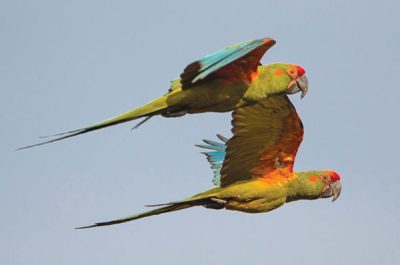Red-fronted Macaw: Cliff-Dwelling Endemic Faces Rocky Future
Opinion Advocates for ideas and draws conclusions based on the author/producer’s interpretation of facts and data.
 By Brian Kluepfel
By Brian Kluepfel
In south-central Bolivia’s dry river valleys of Mizque, Grande and Pilcomayo, near the site of Che Guevara’s demise, a cinematic macaw is clawing its way back from the brink, with a little help from its friends. Goats, guns and pesticides pose a problem, yet new population censuses show things may be better than we expect.
I suppose the popular view of macaws is of a bird zipping around the rainforest canopy, living in large-leafed trees, and scoring open hard tropical nuts with their can-opener like beaks. So, when one reads a description of the Red-fronted macaw’s habitat in the IUCN Red List of 2018, it’s a bit of a shock:
Subtropical, xerophytic thorny scrub with many cacti and scattered trees at 1,100-2,700 m, dispersing locally to 3,000 m. It nests and roosts on undisturbed, steep-sided river cliffs, with a small population breeding in palms (Rojas et al. 2012). Its diet includes seeds and fruit, but natural food sources are often scarce and birds feed extensively on crops, particularly groundnuts and unripe maize…
There are just 17 (realistically, probably only 15) species of macaws extant in the wild, but the differences among them continue to amaze me: here’s a macaw that lives at relatively high-altitude desert (an ecolodge which offers sleeping and birding is in Perereta, on the Misque River about equidistant from the population centers of Cochabamba, Santa Cruz, and Sucre, and just north of Vallegrande, where Che Guevara met his demise), amongst the cacti and other xerophytic things (I love that word), and having few trees to nest in, often chooses to dwell in the clay of nearby cliffs. The area gets between 300 to 800 mm (11-31”) of rainfall annually.
Actually, Lear’s Macaws in Brazil live in similar dry scrubby habitat known as caatinga, and also nest in cliff faces as did the extinct-in-the-wild Spix Macaw.
But the big problem for the Red-fronted macaw is not its habitat, but its cohabitants: humans who don’t want to share the ‘unripe maize,’ use pesticides, and have denuded existing potential food/nesting trees by wood-gathering and charcoal production. Thus, the population of the ara rubrogenis has dropped from the low thousands to a few hundred: the IUCN report above lists the bird as Critically Endangered (CR).
I’m continually frustrated to read about an avian species brought to the brink of extinction by human activity. In recent years I’ve written on two other macaw species, the Blue-throated and the Great Green, which are both also Critically Endangered. In the case of the Blue-throat, it also inhabits a special niche environment, limited to a corner of northeastern Bolivia.
Humans-that same wonderful species we’ve just mentioned above–are playing a key role in the preservation of Blue-throats and Great Greens by introducing artificial nest-box programs where trees are absent and working with growers and local towns to promote co-existence with our multicolored avian ambassadors. Bravo to my colleagues at Macaw Recovery Network and Asociación Armonía for their work on those initiatives. Let’s hope they can do the same for the Red-fronted macaw.
There is great discussion these days, appropriately, about the naming of birds. The Red-fronted Macaw seems straightforward enough–it’s named for prominent red patches on its face, crown, and thighs–and the name in the indigenous Quechua language is Qa Qa Loro (parrot of the rocks, which makes sense, too)–but it’s also very rarely called “Lafresnaye’s Macaw,” for the French baron/ornithologist who was among the first to classify it for science.
I would set aside this argument for the moment and pose a second dilemma: what do you call a species of which there are no living members? Extinct.
Brian Kluepfel is a board member of Saw Mill River Audubon and encourages you to take part in their activities, listed below. He also writes for the Lonely Planet travel series, Fodor’s, and many other fine publications, including this one.

Examiner Media – Keeping you informed with professionally-reported local news, features, and sports coverage.


